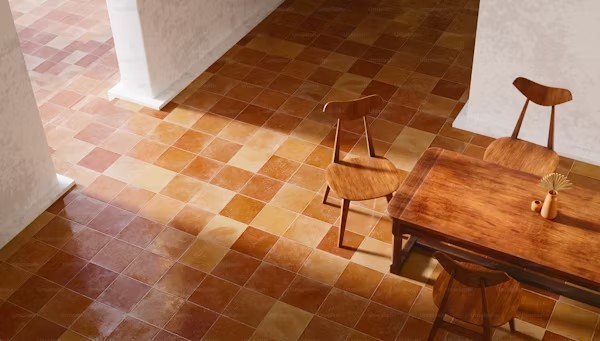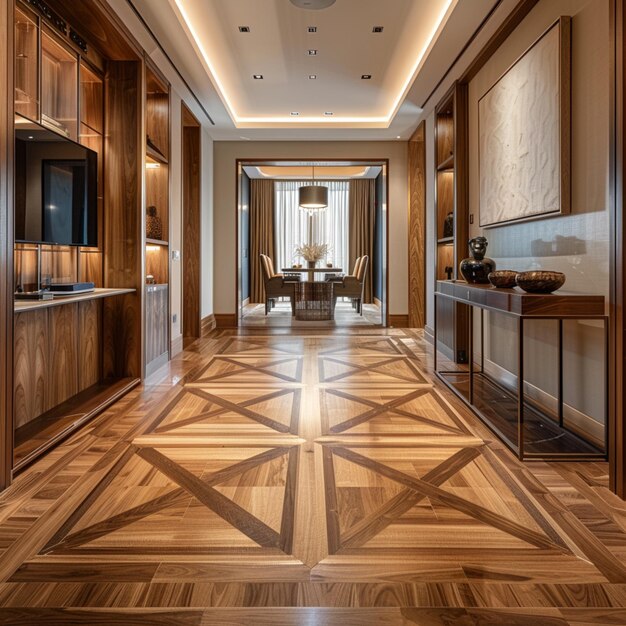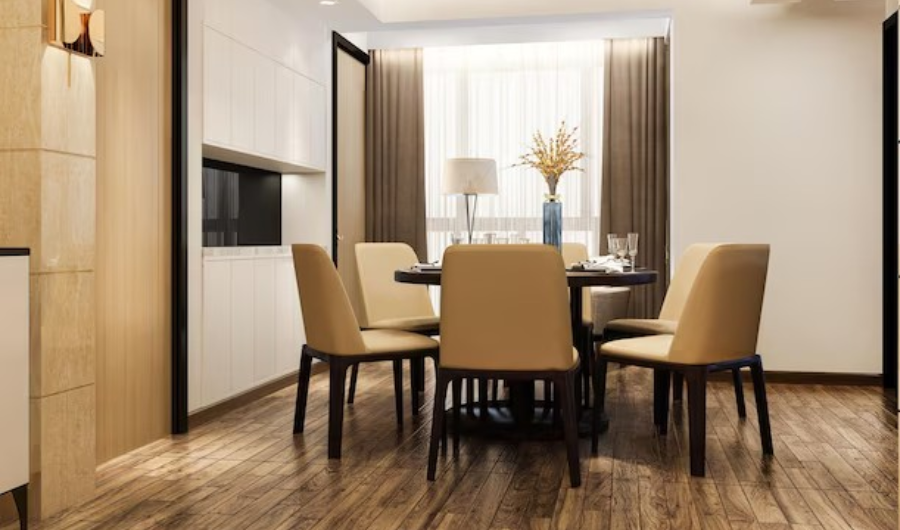Wood flooring has always been a popular option among homeowners because of its warmth and classic appeal. However, it does have drawbacks, including high maintenance costs and vulnerability to water damage. Wood-like tile flooring presents a novel way to combine tile’s practical advantages with hardwood’s visual appeal. In this post, we’ll discuss the advantages, varieties, installation procedures, and maintenance advice for wood-look tile flooring to assist you in making the best choice for your house.
1. What Is Tile Flooring That Looks Like Wood?
Ceramic or porcelain tile mimics real wood’s appearance and feel is known as wood-look tile. Manufacturers replicate the grain, knots, and color variations found in wood with tiles made using sophisticated printing techniques. These tiles, which come in planks and a variety of hues, combine the warmth and beauty of hardwood with the toughness and low upkeep of tile.

2. Benefits of Tile Flooring That Looks Like Wood
Many homeowners find tile flooring that mimics wood to be an appealing option because it offers a number of benefits. Let’s examine a few of the main advantages:
Durability and Strength
Hardwood is more prone to dents, scratches, and water damage than wood-look tile, which is extremely durable. Because of their extreme wear resistance, porcelain and ceramic tiles are perfect for high-traffic areas like living rooms, hallways, and kitchens. They can also withstand moisture, which makes them appropriate for places like basements and bathrooms where wood flooring is normally not recommended.
Low Maintenance
Care for wood-look tile is a lot simpler than hardwood maintenance. There is no need to sand, seal, or refinish these tiles. Usually, regular mopping and sweeping will keep them looking fantastic. Tile is stain and moisture resistant, so you don’t have to be concerned about your floors getting damaged by pet accidents or water spills.
Cost-Effective
While installing and maintaining hardwood flooring can be costly, wood-look tile provides a more affordable option. Wood-look tile typically costs less per square foot than natural hardwood, and because it’s more resilient, you’ll spend less on upkeep and repairs over time.
Versatile Design Options
There is a large variety of styles, colors, and textures available for wood-look tile. There is a wood-look tile to fit your design aesthetic, whether you like the warmth of traditional oak, the sleekness of modern finishes, or the rustic look of reclaimed wood. Additionally, these tiles come in a range of plank sizes, so imaginative layouts and designs are possible.
Eco-Friendly
Hardwood flooring can be replaced with eco-friendly wood-look tile. There is no need to cut down any trees in order to make the tiles because they are made of porcelain or ceramic. To further lessen their impact on the environment, many manufacturers also employ recycled materials in their production processes.
3. Types of Wood-Look Tile

There are two primary varieties of wood-like tile flooring: porcelain and ceramic. Each has benefits, but knowing how they differ can help you decide which is best for your house.
Ceramic Wood-Look Tile
The ingredients for ceramic wood-look tile are water and natural clay. Because it is somewhat less dense than porcelain, it is a more cost-effective choice. Even though ceramic tiles are resilient to water and long-lasting, porcelain tiles might be stronger—especially in high-traffic areas.
Porcelain Wood-Look Tile
Rounded clay is used to create porcelain tiles, which are fired at higher temperatures to produce a denser, more resilient tile. Because porcelain is so resilient to stains, scratches, and moisture, it’s a better material choice for high-traffic areas like kitchens, bathrooms, and entryways where there is a lot of moisture exposure. Because of its resistance to frost, it is also appropriate for outdoor use.
4. Installation Process for Wood-Look Tile
The process of installing wood-look tile is similar to that of installing other kinds of tile flooring, but for optimal results, there are a few considerations.
Preparing the Subfloor
Make sure the subfloor is dry, clean, and level before tiling it. Any irregularity can impact the tile’s final appearance, particularly because wood-look tiles are meant to resemble long, straight planks. To fix flaws, a self-levelling compound might be required.
Layout and Design
Take great care when arranging the tiles. Similar to how hardwood planks are laid, wood-look tiles are usually installed in a staggered pattern. For a more distinctive look, try chevron, diagonal, or herringbone patterns. For a clean finish and to prevent gaps, make sure you measure and cut the tiles precisely.
Grout Selection
Selecting the appropriate grout is crucial to preserving the smooth appearance of wood-look tile. To create the illusion of real wood planks between the tiles, choose grout that is almost the same color as the tiles. For a more realistic appearance, narrow grout lines (1/16 to 1/8 inch) are also advised.
Tile Adhesive
Utilize a premium tile adhesive that is appropriate for either porcelain or ceramic tiles, based on your selection. To ensure that every tile is securely fastened in place, mix and apply the adhesive according to the manufacturer’s instructions.
5. Caring for Your Wood-Look Tile
Although wood-look tile doesn’t require much upkeep, there are a few tricks to keep your floors looking their best:
Regular Cleaning
To get rid of dirt and debris, regularly sweep or vacuum your tile floors. To clean the surface, use a damp mop and a mild cleaner with a pH balance. Scrubbing brushes and other abrasive cleaners should be avoided as they can harm the tile’s finish.
Sealing Grout
Grout can absorb stains and dirt over time, so sealing the grout lines after installation is a good idea. This will shield them from discoloration and keep them looking tidy. Every year or as needed, depending on wear and foot traffic, reseal the grout.
Addressing Chips and Cracks
Even though tile is strong, damage can still occur. It is preferable to replace a chipped or cracked tile rather than try to fix it. For this use, have a few extra tiles left over from the initial installation.
6. Where to Use Tile Flooring That Looks Like Wood
The adaptability of wood-look tile is one of its main advantages. The following are some typical locations where this flooring choice can be applied successfully:

Bathrooms
Wood-look tile is ideal for bathrooms because it offers the warmth of wood without the worry of water damage. It’s resistant to moisture and provides a slip-resistant surface when textured options are chosen.
Kitchens
In the kitchen, durability is essential, and wood-look tile can handle spills, heavy foot traffic, and the occasional dropped dish. It also creates a seamless transition between living areas and open-plan kitchens.
Living Rooms
If you love the look of hardwood in living spaces but need something more durable, wood-look tile is a great choice. Its scratch-resistant surface is ideal for homes with pets and children.
Outdoor Spaces
Some types of wood-look tile, especially porcelain, can be used in outdoor spaces such as patios and walkways. These tiles are frost-resistant and provide the beauty of wood without the maintenance that real wood decking requires.
Final Thoughts

